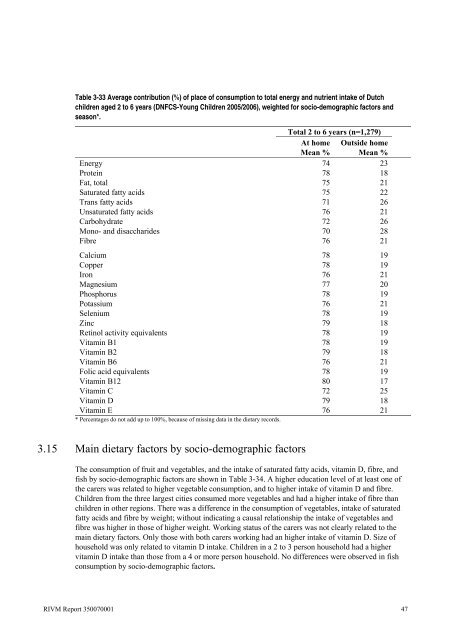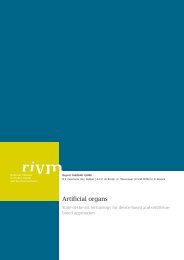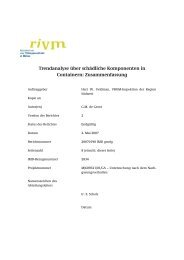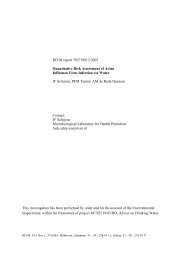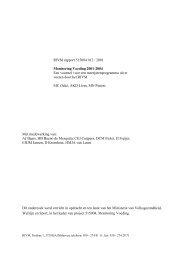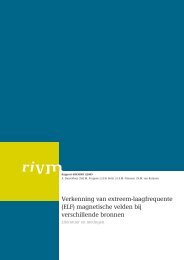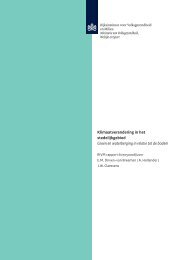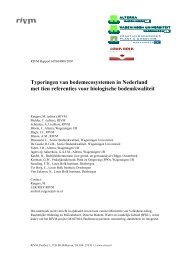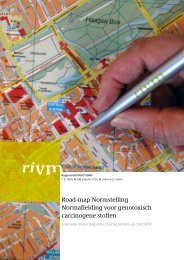RIVM rapport 350070001 Dutch National Food Consumption Survey ...
RIVM rapport 350070001 Dutch National Food Consumption Survey ...
RIVM rapport 350070001 Dutch National Food Consumption Survey ...
You also want an ePaper? Increase the reach of your titles
YUMPU automatically turns print PDFs into web optimized ePapers that Google loves.
Table 3-33 Average contribution (%) of place of consumption to total energy and nutrient intake of <strong>Dutch</strong><br />
children aged 2 to 6 years (DNFCS-Young Children 2005/2006), weighted for socio-demographic factors and<br />
season*.<br />
Total 2 to 6 years (n=1,279)<br />
At home Outside home<br />
Mean % Mean %<br />
Energy 74 23<br />
Protein 78 18<br />
Fat, total 75 21<br />
Saturated fatty acids 75 22<br />
Trans fatty acids 71 26<br />
Unsaturated fatty acids 76 21<br />
Carbohydrate 72 26<br />
Mono- and disaccharides 70 28<br />
Fibre 76 21<br />
Calcium 78 19<br />
Copper 78 19<br />
Iron 76 21<br />
Magnesium 77 20<br />
Phosphorus 78 19<br />
Potassium 76 21<br />
Selenium 78 19<br />
Zinc 79 18<br />
Retinol activity equivalents 78 19<br />
Vitamin B1 78 19<br />
Vitamin B2 79 18<br />
Vitamin B6 76 21<br />
Folic acid equivalents 78 19<br />
Vitamin B12 80 17<br />
Vitamin C 72 25<br />
Vitamin D 79 18<br />
Vitamin E 76 21<br />
* Percentages do not add up to 100%, because of missing data in the dietary records.<br />
3.15 Main dietary factors by socio-demographic factors<br />
The consumption of fruit and vegetables, and the intake of saturated fatty acids, vitamin D, fibre, and<br />
fish by socio-demographic factors are shown in Table 3-34. A higher education level of at least one of<br />
the carers was related to higher vegetable consumption, and to higher intake of vitamin D and fibre.<br />
Children from the three largest cities consumed more vegetables and had a higher intake of fibre than<br />
children in other regions. There was a difference in the consumption of vegetables, intake of saturated<br />
fatty acids and fibre by weight; without indicating a causal relationship the intake of vegetables and<br />
fibre was higher in those of higher weight. Working status of the carers was not clearly related to the<br />
main dietary factors. Only those with both carers working had an higher intake of vitamin D. Size of<br />
household was only related to vitamin D intake. Children in a 2 to 3 person household had a higher<br />
vitamin D intake than those from a 4 or more person household. No differences were observed in fish<br />
consumption by socio-demographic factors.<br />
<strong>RIVM</strong> Report <strong>350070001</strong> 47


